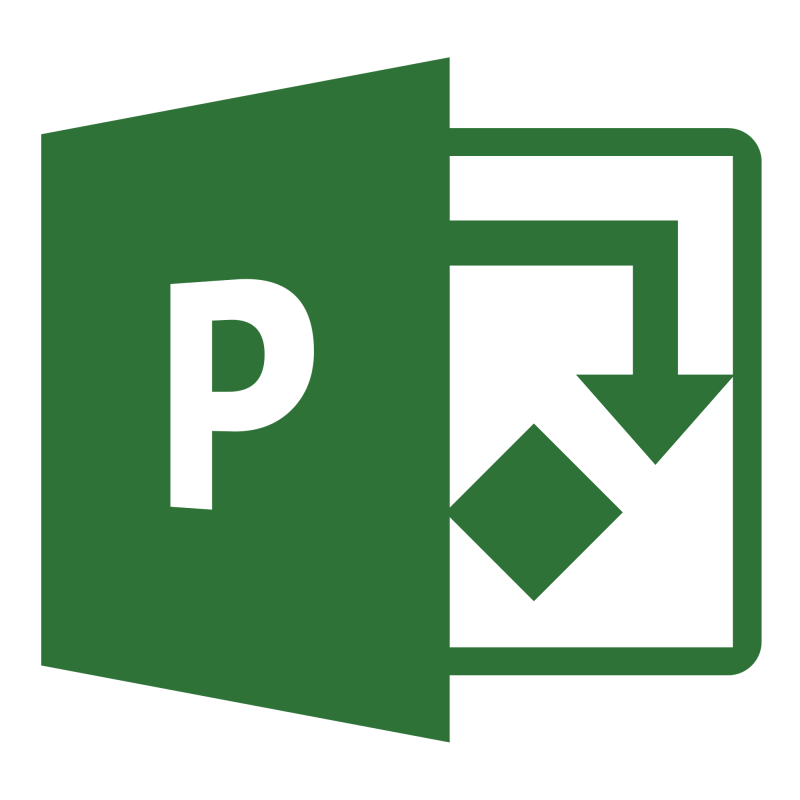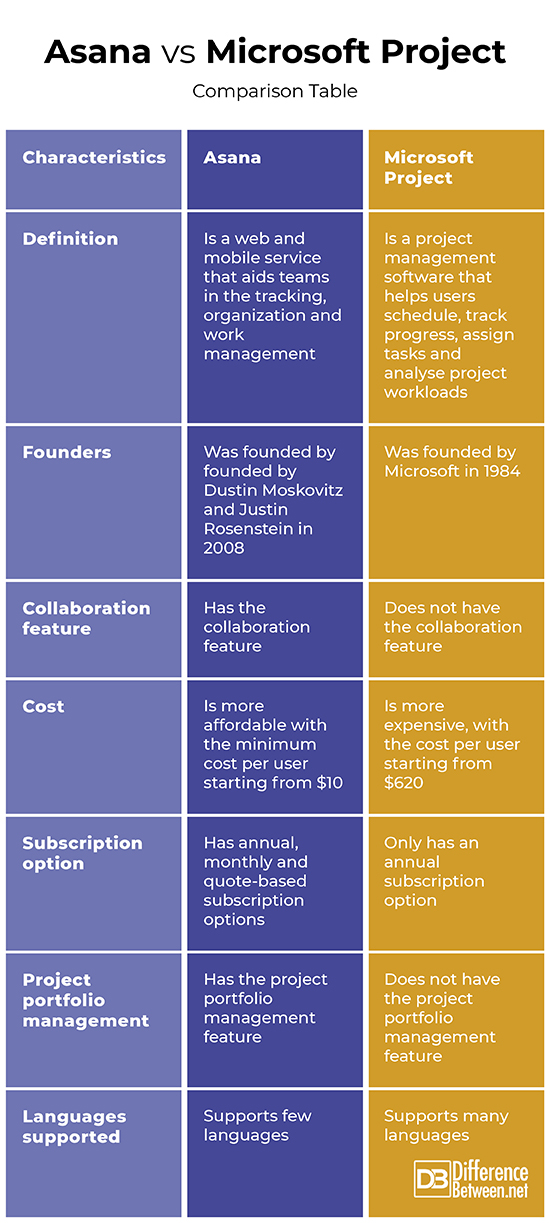Difference Between Asana and Microsoft Project
Web-based service providers have increased in the recent past. While this can be blamed on technology innovation as well as changes in consumer needs and markets, the convenience is unmatched. What are web-based services, you may ask? Web-based services are information exchange systems that take advantage of the internet for user-based interaction. The interaction can be based on objects, documents, programs and even messages. Even with the thousand of web-based tools, consumers still have preferences based on features. In this article, we will look at the difference between Asana and Microsoft Project.

What is Asana?
Asana is a web and mobile service that aids teams in tracking, organization and work management. The company was founded by Dustin Moskovitz and Justin Rosenstein in 2008.
With a single tool, teams can manage tasks as well as projects. Whether you want to specify deadlines, assign work to other team members as well as enjoy other services such as calendars, file attachments and reporting tools, Asana is the perfect web-based tool.
Among some features that users enjoy include:
- Timeline view- This is an integration of the Gantt chart that allows ease of assigning tasks to dependencies as well as team members. Users can see how tasks inter-relate which allows them to organize them in a way that enhances efficiency. And with the ability to reschedule or reorder taka, any roadblocks can be eliminated with ease.
- Teams- Users can create teams where each is assigned duties. For instance, an organization can use Asana to group members according to their respective departments such as sales and finance.
- Reporting and notifications- Project assessment remains one of the most complex issues in organizations. However, with the Reporting and notifications feature, users assess how a project is progressing enabling them to see useful features such as the start as well as the end of a project.
- Calendar- This allows users to view tasks that are set to be completed in a given timeframe. With this schedule, users can see project conflicts or overlaps.
- Files- This allows the uploading of documents to specific files. The files feature is especially important to tasks that require extra data from other documents such as PDF, spreadsheets or word documents.
- Portfolio- This allows the assembly of projects in one area. It also allows the progress of projects to be viewed at the same time.
- Integration and Mobile App- Users can integrate Asana with over 100 digital platforms such as Dropbox, Outlook, Gmail and Slack. The Asana app can also be used on Android and iOS devices.

What is Microsoft Project?
Developed by Microsoft, this is a project management software that helps users schedule, track progress, assign tasks and analyze project workloads. Part of the Microsoft Office family, the web integration tool is available in two editions, the professional and standard editions.
Features of Microsoft Project include:
- Planning and scheduling- Being among the most important stages of project management, this feature makes project management easier. It specifies when and how each stage of the project should be handled, from start to completion. As such, teams can prioritize and manage tasks efficiently.
- Collaboration- Projects often involve many people, hence the need for collaboration. Microsoft Projects’ collaboration feature is enhanced by file sharing, sharing client data and team dashboard.
- Project Timeline View- This feature enables teams working on a project to view the projects’ progress in one place. The synced schedules enable the ease of tracking the projects’ progress.
- Reporting- Tracking the progress of a project is essential. And with the reporting feature, it is easy to track the progress of a project. Teams can hence see which part of a project needs more attention.
- Resource management- This feature enables teams to manage resources involved from the completion to the end of a project. These can be monetary resources, human resources as well as raw materials.
- Different views- Users have the option of using different views such as the Gantt Chart, calendar and resource usage chart. This ensures that users can view projects from different representations and perspectives.
- Multiple projects- Most times, organizations have more than one project running at the same time. With the Master Project Plan, users can deal with different projects on the same platform.
Similarities between Asana and Microsoft project
- Both do not have a time tracking feature
- Both do not offer scrum support
Differences between Asana and Microsoft project
Definition
Asana is a web and mobile service that aids teams in tracking, organization and work management. On the other hand, Microsoft Project is a project management software that helps users schedule, track progress, assign tasks and analyze project workloads.
Founders
Asana was founded by Dustin Moskovitz and Justin Rosenstein in 2008. On the other hand, Microsoft Project was founded by Microsoft in 1984.
Collaboration feature
Asana has the collaboration feature while Microsoft Project does not.
Cost
Asana is more affordable with the minimum cost per user starting from $10. On the other hand, Microsoft Project is more expensive, with the cost per user starting from $620.
Subscription options
Asana has annual, monthly and quote-based subscription options. On the other hand, Microsoft Project has an annual subscription option.
Project portfolio management
While Asana has the project portfolio management feature, Microsoft Project does not have the project portfolio management feature.
Languages supported
While Asana supports few languages, Microsoft Project supports many languages.
Asana vs. Microsoft Project: Comparison Table

Summary of Asana vs. Microsoft Project
Asana is a web and mobile service that aids teams in tracking, organization and work management. Founded by Dustin Moskovitz and Justin Rosenstein in 2008, the platform offers affordable packages, with an initial cost of $10 per user. On the other hand, Microsoft Project is a project management software that helps users in schedule, track progress, assign tasks and analyze project workloads. It is best suited for complex projects. It is also more expensive, with the cost per user starting from $620. However, both remain essential collaborative tools, especially in projects.
- Difference Between Profit Center and Investment Center - July 2, 2022
- Difference Between Anti-Trust and Anti-Competition - June 6, 2022
- Difference Between Stocktaking and Stock Control - June 6, 2022
Search DifferenceBetween.net :
Leave a Response
References :
[0]Costanzo S & Rocha A. Trends and Advances in Information Systems and Technologies: Volume 1. Springer Publishers, 2018. https://books.google.co.ke/books?id=Fw5TDwAAQBAJ&pg=PA1029&dq=Difference+between+asana+and+Microsoft+project&hl=en&sa=X&ved=2ahUKEwjgtdfpiJnwAhXfEWMBHXShAvcQ6AEwAHoECAQQAg#v=onepage&q=Difference%20between%20asana%20and%20Microsoft%20project&f=false
[1]Wood G & Turban E. Information Technology for Management: Driving Digital Transformation to Increase Local and Global Performance, Growth and Sustainability. John Wiley & Sons, 2021. https://books.google.co.ke/books?id=vqAeEAAAQBAJ&pg=PA528&dq=Difference+between+asana+and+Microsoft+project&hl=en&sa=X&ved=2ahUKEwjH4qjziJnwAhUrDmMBHU3pAAo4ChDoATADegQIBBAC#v=onepage&q=Difference%20between%20asana%20and%20Microsoft%20project&f=false
[2]Dux Raymond Sy. SharePoint for Project Management: How to Create a Project Management Information System (PMIS) with SharePoint. "O'Reilly Media, Inc.", 2008. https://books.google.co.ke/books?id=qjgw9v_vOYgC&printsec=frontcover&dq=Difference+between+asana+and+Microsoft+project&hl=en&sa=X&ved=2ahUKEwjH4qjziJnwAhUrDmMBHU3pAAo4ChDoATAJegQICBAC#v=onepage&q&f=false
[3]Image credit: https://commons.wikimedia.org/wiki/File:MS_Project_Logo.png
[4]Image credit: https://commons.wikimedia.org/wiki/File:Asana_logo_new.png
